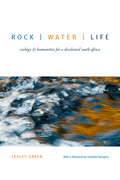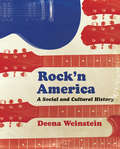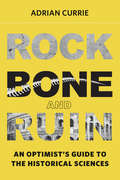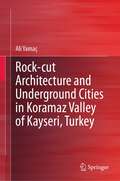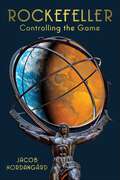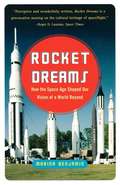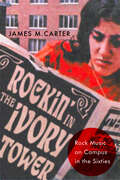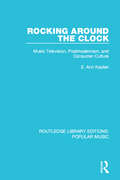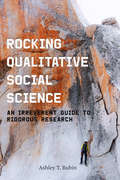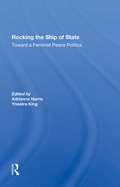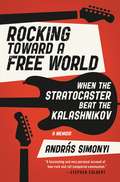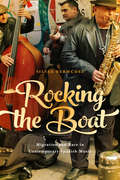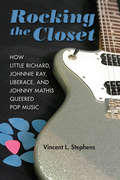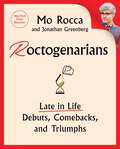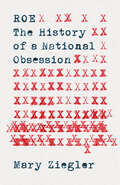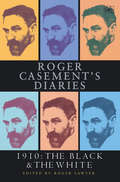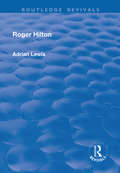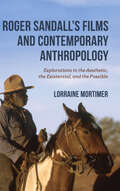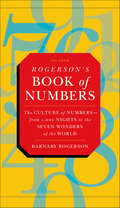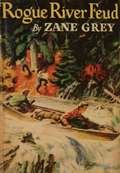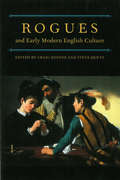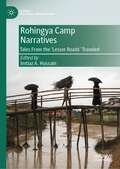- Table View
- List View
Rock | Water | Life: Ecology and Humanities for a Decolonial South Africa
by Lesley GreenIn Rock | Water | Life Lesley Green examines the interwoven realities of inequality, racism, colonialism, and environmental destruction in South Africa, calling for environmental research and governance to transition to an ecopolitical approach that could address South Africa's history of racial oppression and environmental exploitation. Green analyzes conflicting accounts of nature in environmental sciences that claim neutrality amid ongoing struggles for land restitution and environmental justice. Offering in-depth studies of environmental conflict in contemporary South Africa, Green addresses the history of contested water access in Cape Town; struggles over natural gas fracking in the Karoo; debates about decolonizing science; the potential for a politics of soil in the call for land restitution; urban baboon management; and the consequences of sending sewage to urban oceans.
Rock'n America: A Social And Cultural History
by Deena WeinsteinWhat is rock? This book offers a new and systematic approach to understanding rock by applying sociological concepts in a historical context. Deena Weinstein, a rock critic, journalist, and academic, starts by outlining an original approach to understanding rock, explaining how the form has developed through a complex and ever-changing set of relations between artists, fans, and mediators. She then traces the history of rock in America through its distinctive eras, from rock's precursors to rock in the digital age. The book includes suggested listening lists to accompany each chapter, a detailed filmography of movies about rock, and a wide range of visuals and fascinating anecdotes. Never separating rock music from the social, political, economic, and cultural changes in America's history, Rock'n America provides a comprehensive overview of the genre and a new way of appreciating its place in American society.
Rock, Bone, and Ruin: An Optimist's Guide to the Historical Sciences (Life and Mind: Philosophical Issues in Biology and Psychology)
by Adrian CurrieAn argument that we should be optimistic about the capacity of “methodologically omnivorous” geologists, paleontologists, and archaeologists to uncover truths about the deep past. The “historical sciences”—geology, paleontology, and archaeology—have made extraordinary progress in advancing our understanding of the deep past. How has this been possible, given that the evidence they have to work with offers mere traces of the past? In Rock, Bone, and Ruin, Adrian Currie explains that these scientists are “methodological omnivores,” with a variety of strategies and techniques at their disposal, and that this gives us every reason to be optimistic about their capacity to uncover truths about prehistory. Creative and opportunistic paleontologists, for example, discovered and described a new species of prehistoric duck-billed platypus from a single fossilized tooth. Examining the complex reasoning processes of historical science, Currie also considers philosophical and scientific reflection on the relationship between past and present, the nature of evidence, contingency, and scientific progress.Currie draws on varied examples from across the historical sciences, from Mayan ritual sacrifice to giant Mesozoic fleas to Mars's mysterious watery past, to develop an account of the nature of, and resources available to, historical science. He presents two major case studies: the emerging explanation of sauropod size, and the “snowball earth” hypothesis that accounts for signs of glaciation in Neoproterozoic tropics. He develops the Ripple Model of Evidence to analyze “unlucky circumstances” in scientific investigation; examines and refutes arguments for pessimism about the capacity of the historical sciences, defending the role of analogy and arguing that simulations have an experiment-like function. Currie argues for a creative, open-ended approach, “empirically grounded” speculation.
Rock-cut Architecture and Underground Cities in Koramaz Valley of Kayseri, Turkey
by Ali YamaçIn this book, rock-cut and underground structures of Koramaz Valley on the Anatolian Plateau in Turkey are described in detail. The valley; located in eastern Turkey near the town of Kayseri, has hundreds of rock-cut structures, in addition to several underground cities, and almost none of them have been studied before. Research conducted by a team from 2014 to 2020, resulted in this overview of all the rock-cut and underground structures in and around seven different settlements in the valley and aims for the physical documentation and inventory of all these structures. The book studies cliff settlements, rock-cut churches, underground cities, and funerary architecture in the valley. These shelters are estimated to have been built between the 7th and 10th centuries and even the smallest of these structures offer rich details for architectural, socio-cultural and historical studies. The rock-cut churches date to the Byzantine Empire period and during the research period, over 400 of these structures were explored, surveyed, and mapped in the region and with all these historical and natural values. Recently, the Koramaz Valley was accepted to the UNESCO World Heritage tentative list. This book is of interest to archaeologists and scholars of built heritage.
Rockefeller: Controlling the Game
by Jacob NordangårdWhy would the first family of oil so ardently support environmental climate research and activism? Join author and researcher Jacob Nordangård as he uncovers the whole sordid truth. The Rockefeller family is one of the richest in the world. Yet, why would the family that made the world dependent on oil fund environmental and climate research since the 1950s, help shape climate policy measures since the 1980s, and supported climate activism since the 1990s? Rockefeller: Controlling the Game is the thrilling and paradoxical story of one of the world's most influential global players. Through its top position in American business, close contacts with the White House, and with their immense financial power as one of the world's leading private research funders, the Rockefellers have been able to anchor the climate issue both scientifically and politically. Yet what is the reasoning behind doing so? Author and researcher Jacob Nordangård follows the family from the founding of Standard Oil and the Rockefeller Foundation, up through the aftermath of the Paris Agreement, with the declaration of the Fourth Industrial Revolution in January 2016, to the present day. Nordangård's in-depth research includes the large quantities of new material recently made available on the Internet, as well as the Rockefeller Foundation's own annual reports. Nordangård's main focus is the Rockefeller family's involvement in climate research and politics, but the actions and motives of some of their allies are also explored, as well as the family's influence on the development of modern medicine, family planning, agriculture, art, architecture, behavioral science, information technology, and politics. The Rockefeller family's utopian dream of a perfect world will have serious consequences for the survival of the human species and life as we know it. The Rockefeller Foundation's stated mission to "promote the well-being of humanity throughout the world" has a dark flipside, as, Nordangård will prove, the Rockefeller family's long-standing battle against climate change contains elements of sophisticated propaganda techniques, futurism, and New Age philosophy, aiming at a complete transformation of the whole earth system, including economy, ecology, culture, and even humanity itself.
Rocket Dreams: How the Space Age Shaped Our Vision of the World
by Marina BenjaminIn 1958, mankind's centuries-long flirtation with space flight became a torrid love affair. For a decade, tens of millions of people were enraptured -- first, by the U.S.-Soviet race to the moon, and finally, as America outstripped its rival, by Project Apollo alone. It is now more than three decades since the last man walked on the moon...more time than between the first moonwalk and the beginning of World War II. Apollo did not, as had been promised by a generation of visionaries, herald the beginning of the Space Age, but its end. Or did it? Project Apollo, like a cannonball, reached its apogee and returned to earth, but the trajectory of that return was complex. America's atmosphere -- its economic, scientific, and cultural atmosphere -- made for a very complicated reentry that produced many solutions to the trajectory problem. Rocket Dreams is about those solutions...about the places where the space program landed. In Rocket Dreams, an extraordinarily talented young writer named Marina Benjamin will take you on a journey to those landing sites. A visit with retired astronauts at a celebrity autograph show is a starting point down the divergent paths taken by the pioneers, including Edgar Mitchell, founder of the "church" of Noëtic Sciences. Roswell, New Mexico is a landing site of a different order, the "magnetic north" of UFO belief in the United States -- a belief that began its most dramatic growth precisely at the time that the path of the space program began its descent. In the vernacular, the third law of motion states that what goes up, must come down. Thus the tremendous motive force that energized the space program didn't just vanish; it was conserved and transformed, making bestsellers out of fantasy literature, spawning Gaia, and giving symbolism to the environmental movement. Everything from the pop cultural boom in ufology to the worldwide Search for Extra-Terrestrial Intelligence (SETI) feeds on the energy given off by America's leap toward space. Rocket Dreams is an eloquent tour of this Apollo-scarred landscape. It is also an introduction to some of the most fascinating characters imaginable: Some long dead, like the crackpot visionary Alfred Lawson, who saw in space flight a new stage of human evolution ("Alti-Man"), or Robert Goddard, the father of rocketry, whose workshop in Roswell stands only half a mile from shops selling posters of alien visitors. Others are very much alive -- like Stewart Brand, creator of the Whole Earth Catalog and partner with Gerard O'Neill in the drive to build free-floating space colonies, and SETI astronomer Seth Shostak, who has spent decades listening to the skies, hoping for the first contact with another intelligent species. Perceptive, original, and wonderfully written, informed by history, science, and an acute knowledge of popular culture, Rocket Dreams is a brilliant book by a remarkable talent.
Rockin' in the Ivory Tower: Rock Music on Campus in the Sixties (CERES: Rutgers Studies in History)
by James M. CarterHistories of American rock music and the 1960s counterculture typically focus on the same few places: Woodstock, Monterey, Altamont. Yet there was also a very active college circuit that brought edgy acts like the Jefferson Airplane and the Velvet Underground to different metropolitan regions and smaller towns all over the country. These campus concerts were often programmed, promoted, and reviewed by students themselves, and their diverse tastes challenged narrow definitions of rock music. Rockin’ in the Ivory Tower takes a close look at two smaller universities, Drew in New Jersey and Stony Brook on Long Island, to see how the culture of rock music played an integral role in student life in the late 1960s. Analyzing campus archives and college newspapers, historian James Carter traces connections between rock fandom and the civil rights protests, free speech activism, radical ideas, lifestyle transformations, and anti-war movements that revolutionized universities in the 1960s. Furthermore, he finds that these progressive students refused to segregate genres like folk, R&B, hard rock, and pop. Rockin’ in the Ivory Tower gives readers a front-row seat to a dynamic time for the music industry, countercultural politics, and youth culture.
Rocking Around the Clock: Music Television, Postmodernism, and Consumer Culture (Routledge Library Editions: Popular Music #9)
by E. Ann KaplanThe first non-stop rock video channel was launched in the US in 1981. As a unique popular culture form, MTV warrants attention, and in this, the first study of the medium, originally published in 1987, Ann Kaplan examines the cultural context of MTV and its relationship to the history of rock music. The first part of the book focuses on MTV as a commercial institution, on the contexts of production and exhibition of videos, on their similarity to ads, and on the different perspectives of directors and viewers. Does the adoption of adolescent styles and iconography signal an open-minded acceptance of youth’s subversive stances; or does it rather suggest a cynicism by which profit has become the only value? In the second part of the book, Kaplan turns to the rock videos themselves, and from the mass of material that flows through MTV she identifies five distinct types of video: the ‘romantic’, the ‘socially conscious’, the ‘nihilistic’, the ‘classical’, and the ‘postmodern’. There are detailed analyses of certain videos; and Kaplan focuses particularly on gender issues in videos by both male and female stars. The final chapter explores the wider implications of MTV. What does the channel tell us about the state of youth culture at the time?
Rocking Qualitative Social Science: An Irreverent Guide to Rigorous Research
by Ashley T. RubinUnlike other athletes, the rock climber tends to disregard established norms of style and technique, doing whatever she needs to do to get to the next foothold. This figure provides an apt analogy for the scholar at the center of this unique book. In Rocking Qualitative Social Science, Ashley Rubin provides an entertaining treatise, corrective vision, and rigorously informative guidebook for qualitative research methods that have long been dismissed in deference to traditional scientific methods. Recognizing the steep challenges facing many, especially junior, social science scholars who struggle to adapt their research models to narrowly defined notions of "right," Rubin argues that properly nourished qualitative research can generate important, creative, and even paradigm-shifting insights. This book is designed to help people conduct good qualitative research, talk about their research, and evaluate other scholars' work. Drawing on her own experiences in research and life, Rubin provides tools for qualitative scholars, synthesizes the best advice, and addresses the ubiquitous problem of anxiety in academia. Ultimately, this book argues that rigorous research can be anything but rigid.
Rocking The Ship Of State: Toward A Feminist Peace Politics
by Carol Cohn Adrienne Harris Ynestra KingThis book considers the experience of women as children and as mothers, and feminist critiques of gender as important sources of insight into the conduct, dynamics, and motivation of a feminist peace politics, examining the history, the scope, and the current condition of women's peace movements.
Rocking Toward a Free World: When the Stratocaster Beat the Kalashnikov
by András SimonyiFrom renowned diplomat and musician András Simonyi -- whom Stephen Colbert calls "the only ambassador I know who can shred a mean guitar!" -- comes a timely and revealing memoir about growing up behind the Iron Curtain and longing for freedom while chasing the great power of rock and roll. p.p1 {margin: 0.0px 0.0px 0.0px 0.0px; text-indent: 36.0px; font: 12.0px Arial} In ROCKING TOWARD A FREE WORLD, Simonyi charts the struggle of growing up in 1960s Hungary, a world in which listening to his favorite music was a powerful but furtive endeavor: records were black-market bootlegs; concerts were held under strict control, even banned; protests were folded into song lyrics. Get caught listening to Western radio could mean punishment, maybe prison. That didn't matter to Simonyi, who from an early age felt the tremendous pull of rock and roll, the lure of American popular culture, and a burning desire to buck the system. Inspired by the protest music coming out of the West, he formed a band and became part of Hungary's burgeoning rock scene. Then came the setbacks: tightening of control by the state, the seemingly inescapable weight of an authoritarian system, and the collapse of Simonyi's own dreams of stardom. A story of youth, rebellion, and hope, ROCKING TOWARD A FREE WORLD sheds new light on two of the most powerful forces of the modern age: global democracy and rock and roll. Deeply vital and compelling, Simonyi's memoir chronicles how one man's tremendous connection to American and British popular music inspired him to make a difference in his country and, eventually, the world. It tells the story of a generation, as played out in song lyrics and guitar riffs. p.p1 {margin: 0.0px 0.0px 0.0px 0.0px; font: 13.0px Times} p.p2 {margin: 0.0px 0.0px 0.0px 0.0px; font: 13.0px Times; min-height: 16.0px}
Rocking the Boat: Migration and Race in Contemporary Spanish Music (Toronto Iberic)
by Silvia BermudezSilvia Bermúdez’s fascinating study reveals how Spanish popular music, produced between 1980 and 2013, was the first cultural site to engage in critical debate about ethnicity and race in relation to the immigration patterns that have been changing the social landscape of Spanish society since the late 1970s. In Rocking the Boat, Bermúdez examines the lyrics of songs by both renowned and up and coming artists to illuminate how these new migrants challenged Spain’s notions of homogeneity, boundaries, accommodation, and incorporation. Bermúdez observes that immigration has had such a significant influence on Spanish society that the tattered boats, seen to this day on the shores of Spain and throughout the Mediterranean Sea, have become inverted emblems of the ships that were once symbols of great power and economic development. Rocking the Boat is a nuanced account of how popular urban music shaped the discourse on immigration, transnational migrants, and racialization in Spain’s new social landscape.
Rocking the Closet: How Little Richard, Johnnie Ray, Liberace, and Johnny Mathis Queered Pop Music (New Perspectives on Gender in Music #24)
by Vincent L StephensThe all-embracing, "whaddya got?" nature of rebellion in Fifties America included pop music's unlikely challenge to entrenched notions of masculinity. Within that upheaval, four prominent artists dared to behave in ways that let the public assume—but not see—their queerness. That these artists cultivated ambiguous sexual personas often reflected an understandable fear, but also a struggle to fulfill personal and professional expectations.Vincent L. Stephens confronts notions of the closet—both coming out and staying in—by analyzing the careers of Liberace, Johnny Mathis, Johnnie Ray, and Little Richard. Appealing to audiences hungry for novelty and exoticism, the four pop icons used performance and queering techniques that ran the gamut. Liberace's flamboyance shared a spectrum with Mathis's intimate sensitivity while Ray's overwrought displays as "Mr. Emotion" seemed worlds apart from Little Richard's raise-the-roof joyousness. As Stephens shows, the quartet not only thrived in an era of gray flannel manhood, they pioneered the ways generations of later musicians would consciously adopt sexual mystery as an appealing and proven route to success.
Rocks and Rifles: The Influence of Geology on Combat and Tactics during the American Civil War (Advances in Military Geosciences)
by Scott HippensteelThis book discusses the relationship between geology and fighting during the American Civil War. Terrain was largely determined by the underlying rocks and how the rocks weathered. This book explores the difference in rock type between multiple battlegrounds and how these rocks influenced the combat, tactics, and strategies employed by the soldiers and their commanding officers at different scales.
Roctogenarians: Late in Life Debuts, Comebacks, and Triumphs
by Mo Rocca Jonathan GreenbergFrom beloved CBS Sunday Morning correspondent Mo Rocca, author of New York Times bestseller Mobituaries, comes an inspiring collection of stories that celebrates the triumphs of people who made their biggest marks late in life. Eighty has been the new sixty for about twenty years now. In fact, there have always been late-in-life achievers, those who declined to go into decline just because they were eligible for social security. Journalist, humorist, and history buff Mo Rocca and coauthor Jonathan Greenberg introduce us to the people past and present who peaked when they could have been puttering—breaking out as writers, selling out concert halls, attempting to set land-speed records—and in the case of one ninety-year tortoise, becoming a first-time father. (Take that, Al Pacino!) In the vein of Mobituaries, Roctogenarians is a collection of entertaining and unexpected profiles of these unretired titans—some long gone (a cancer-stricken Henri Matisse, who began work on his celebrated cut-outs when he could no longer paint), some very much still living (Mel Brooks, yukking it up at close to one hundred). The amazing cast of characters also includes Mary Church Terrell, who at eighty-six helped lead sit-ins at segregated Washington, DC, lunch counters in the 1950s, and Carol Channing, who married the love of her life at eighty-two. Then there&’s Peter Mark Roget, who began working on his thesaurus in his twenties and completed it at seventy-three (because sometimes finding the right word takes time.) With passion and wonder Rocca and Greenberg recount the stories of yesterday&’s and today&’s strongest finishers. Because with all due respect to the Golden Girls, some people will never be content sitting out on the lanai. (PS Actress Estelle Getty was sixty-two when she got her big break. And yes, she&’s in the book.)
Roe: The History of a National Obsession
by Mary ZieglerThe leading U.S. expert on abortion law charts the many meanings associated with Roe v. Wade during its fifty-year history “Ziegler sets a brisk pace but delivers substantial depth. . . . A must-read for those seeking to understand what comes next.”—Publishers Weekly What explains the insistent pull of Roe v. Wade? Abortion law expert Mary Ziegler argues that the U.S. Supreme Court decision, which decriminalized abortion in 1973 and was overturned in 2022, had a hold on us that was not simply the result of polarized abortion politics. Rather, Roe took on meanings far beyond its original purpose of protecting the privacy of the doctor-patient relationship. It forced us to confront questions about sexual violence, judicial activism and restraint, racial justice, religious liberty, the role of science in politics, and much more. In this history of what the Supreme Court’s best-known decision has meant, Ziegler identifies the inconsistencies and unsettled issues in our abortion politics. She urges us to rediscover the nuance that has long resided where we would least expect to find it—in the meaning of Roe itself.
Roger Casement's Diaries: 1910:The Black and the White
by Roger SawyerBorn in Ireland in 1864 Roger Casement acted as British Consul in various parts of Africa (1895-1904) and Brazil (1906-11) where he denounced atrocities among Congolese and Putumayo rubber workers. knighted in 1911, He returned to Ireland, where as an ardent nationalist he attempted to enlist German help for the cause. He was hanged for high treason in London in 1916. A compulsive diary writer, his so-called 'Black' Diaries were finally released into the public domain in 1994. At the time of his trial, these diaries-detailing his promiscuous homosexual activities in Brazil-were used to condemn him and, subsequently, to poison his reputation. Published here for the first time-as are his more public 'White' Diaries of the same year-they not only offer the reader the opportunity to judge their authenticity-still a matter of heated debate-but they also take us deep into the mind of the bravest, most selfless and practical humanitarian of the Edwardian age.
Roger Dahl's Comic Japan
by Roger DahlRoger Dahl's Zero Gravity cartoon strip has been a popular feature of Japan's leading English-language daily newspaper, The Japan Times, since 1991. Now, for the first time, Roger Dahl's Comic Japan brings together the best of Zero Gravity in book form. Offering a Western artist's take on Japan, the strip stars Larry and Lily, a young American couple working as English teachers in Tokyo. Larry and Lily never manage to fully integrate into Japanese society, and Zero Gravity takes a whimsical approach to the meeting of cultures as well as the quirky dynamics of changing relationships between generations and subgroups within Japan. Besides Larry and Lily, Zero Gravity features their close friends, the Koyama family, whose three very different generations encounter plenty of misunderstandings of their own! This anthology contains eight chapters featuring the best selection of strips from Larry and Lily's life in Japan. Each chapter opens with a brief passage about its theme, and a 3-page illustrated introduction provides information about Dahl, his career, and his inspiration for Zero Gravity. Graphic novels and comic books have experienced explosive growth in recent years, and Roger Dahl's Comic Japan offers humorous cross-cultural observations that will delight visitors to Japan and armchair travelers alike.
Roger Hilton
by Adrian LewisThis title was first published in 2003. Twenty-seven years after his death, Roger Hilton's reputation as a leading figure in British 'abstract expressionism' continues to rise. Following the major retrospective exhibition at the Hayward Gallery in 1993 and the drawings survey at the Tate St Ives in 1997, this lavishly illustrated account is the first to provide a comprehensive overview of the life and work of this important artist. Hilton's extraordinary career is discussed in all its phases, from the intriguing earliest explorations in paint to the inception of his first abstract pieces around 1950 and the complex and intriguing interchanges of imagery and form that mark his final works. Adrian Lewis explains the artist's mature works as both attracting the viewer and resisting easy reading, and discusses in detail the artist's debt to the Ecole de Paris and his relation to the notion of the 'act of painting' that pervaded post-war culture.
Roger Sandall's Films and Contemporary Anthropology: Explorations in the Aesthetic, the Existential, and the Possible
by Lorraine MortimerA look at a prize-winning documentarian whose work with aboriginal Australians and others united the fields of film and anthropology in the 1960s and ‘70s.In Roger Sandall’s Films and Contemporary Anthropology, Lorraine Mortimer argues that while social anthropology and documentary film share historic roots and goals, particularly on the continent of Australia, their trajectories have tended to remain separate. This book reunites film and anthropology through the works of Roger Sandall, a New Zealand–born filmmaker and Columbia University graduate, who was part of the vibrant avant-garde and social documentary film culture in New York in the 1960s.Mentored by Margaret Mead in anthropology and Cecile Starr in fine arts, Sandall was eventually hired as the one-man film unit at the newly formed Australian Institute of Aboriginal Studies in 1965. In the 1970s, he became a lecturer in anthropology at the University of Sydney. Sandall won First Prize for Documentary at the Venice Film Festival in 1968, yet his films are scarcely known, even in Australia now. Mortimer demonstrates how Sandall’s films continue to be relevant to contemporary discussions in the fields of anthropology and documentary studies. She ties exploration of the making and restriction of Sandall’s aboriginal films and his nonrestricted films made in Mexico, Australia, and India to the radical history of anthropology and the resurgence today of an expanded, existential-phenomenological anthropology that encompasses the vital connections between humans, animals, things, and our environment.
Rogerson's Book of Numbers: The Culture of Numbers—from 1,001 Nights to the Seven Wonders of the World
by Barnaby RogersonTHE STORIES BEHIND OUR ICONIC NUMBERSRogerson's Book of Numbers is based on a numerical array of virtues, spiritual attributes, gods, devils, sacred cities, powers, calendars, heroes, saints, icons, and cultural symbols.It provides a dazzling mass of information for those intrigued by the many roles numbers play in folklore and popular culture, in music and poetry, and in the many religions, cultures, and belief systems of our world.The stories unfold from millions to zero: from the number of the beast (666) to the seven deadly sins; from the twelve signs of the zodiac to the four suits of a deck of cards. Along the way, author Barnaby Rogerson will show you why Genghis Khan built a city of 108 towers, how Dante forged his Divine Comedy on the number eleven, and why thirteen is so unlucky in the West whereas fourteen is the number to avoid in China.
Rogue Angel: The Spiritual Journey of One of the FBI's Ten Most Wanted
by Jodi WerhanowiczMary Kay had a difficult childhood, a bad marriage, when she met Paul and so began her life of crime. Only after imprisonment does she discover Christ. From that time on, her life changes. Eventually she is free and spends the rest of her life working in many facets of prison ministry and rehabilitation work. The book really makes for a good reflection.
Rogue River Feud: A Western Story
by Zane GreyAlong the notorious Rogue River, gold seekers, crazed by the discovery of nuggets that made them rich overnight, are at war with one another. The river itself swarms with salmon, bringing along with them another kind of wealth and violent fighting between fishermen and the fish-packing monopoly. Into this scene comes Keven Bell, returning to face life after being handicapped by a disfiguring wound he received in World War I. Keven teams up with a broken-down fisherman and boatbuilder. When they try to buck the salmon-packing monopoly, they encounter violence and trickery; their boat is sunk and they are left to swim for their lives.Keven is tended to by Beryl, the daughter of a gold miner. His convalescence is slow, but the autumn days, fishing and camping, make a woodland dream of romance. But no sooner has an operation straightened out Keven's injuries than he is framed on a charge of murder in the salmon-packing war. Keven must carry on as best he can, along with what help Beryl and her old father can give, to clear his name and ensure his and Beryl's safety on the turbulent Rogue.Zane Grey's vigorous storytelling and portrayal of violence in the wild make this novel one of his best. There is a deep emotional feeling for nature in the raw, for the great salmon runs, and for the clashes of men fighting for gold.
Rogues and Early Modern English Culture
by Craig Dionne Steve MentzRogues and Early Modern English Culture is a definitive collection of critical essays on the literary and cultural impact of the early modern rogue. Under various names-rogues, vagrants, molls, doxies, vagabonds, cony-catchers, masterless men, caterpillars of the commonwealth-this group of marginal figures, poor men and women with no clear social place or identity, exploded onto the scene in sixteenth-century English history and culture. Early modern representations of the rogue or moll in pamphlets, plays, poems, ballads, historical records, and the infamous Tudor Poor Laws treated these characters as harbingers of emerging social, economic, and cultural changes. Images of the early modern rogue reflected historical developments but also created cultural icons for mobility, change, and social adaptation. The underclass rogue in many ways inverts the familiar image of the self-fashioned gentleman, traditionally seen as the literary focus and exemplar of the age, but the two characters have more in common than courtiers or humanists would have admitted. Both relied on linguistic prowess and social dexterity to manage their careers, whether exploiting the politics of privilege at court or surviving by their wits on urban streets.
Rohingya Camp Narratives: Tales From the ‘Lesser Roads’ Traveled (Global Political Transitions)
by Imtiaz A. HussainThis book presents thirteen chapters which probe the “tales less told” and “pathways less traveled” in refugee camp living. Rohingya camps in Bangladesh since August 2017 supply these “tales” and “pathways”. They dwell upon/reflect camp violence, sexual/gender discrimination, intersectionality, justice, the sudden COVID camp entry, human security, children education, innovation, and relocation plans. Built largely upon field trips, these narratives interestingly interweave with both theoretical threads (hypotheses) and tapestries (net-effects), feeding into the security-driven pulls of political realism, or disseminating from humanitarian-driven socioeconomic pushes, but mostly combining them. Post-ethnic cleansing and post-exodus windows open up a murky future for Rohingya and global refugees. We learn of positive offshoots (of camp innovations exposing civil society relevance) and negative (like human and sex trafficking beyond Bangladeshi and Myanmar borders), as of navigating (a) local–global linkages of every dynamic and (b) fast-moving current circumstances against stoic historical leftovers.
